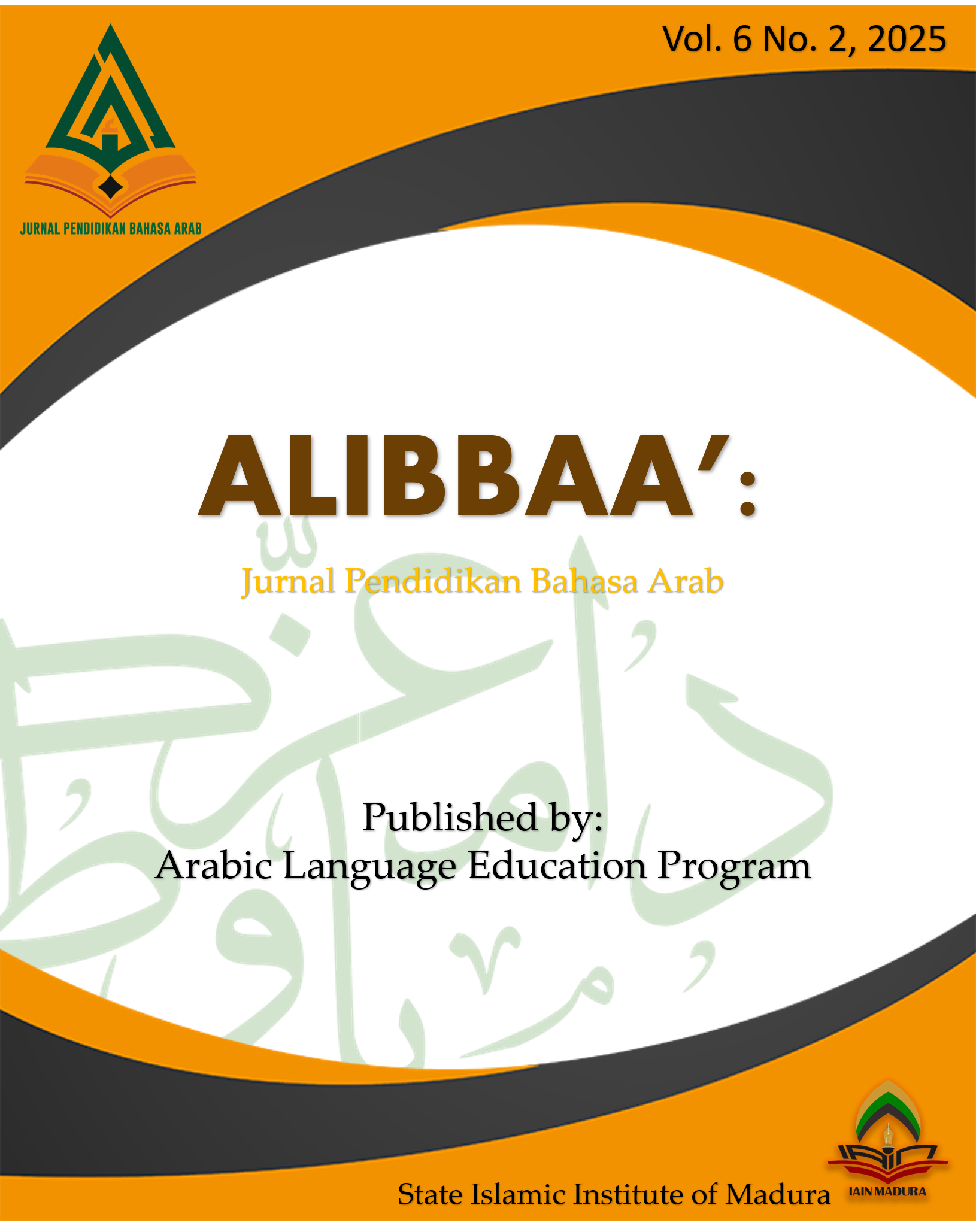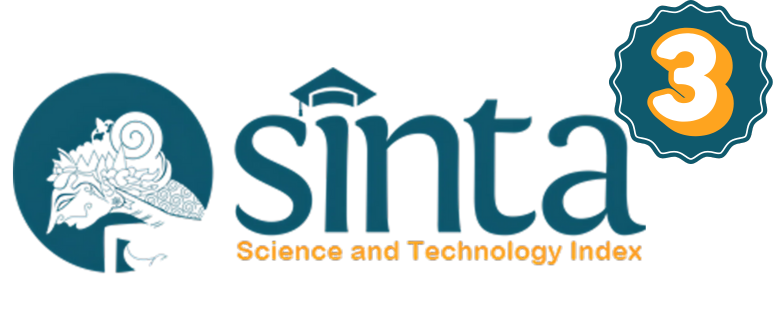The Arabic Linguistic Landscape of Islamic Universities: Patterns, Strategies, and Pedagogical Practices in West Sumatra
 Abstract views: 191
,
Abstract views: 191
,
 pdf downloads: 166
pdf downloads: 166
Abstract
This study investigates the Arabic linguistic landscape in Islamic universities across West Sumatra by examining its writing patterns, strategies, and related pedagogical practices. Employing a mixed-methods approach with an exploratory sequential design grounded in Creswell’s framework, the research found that bottom-up patterns dominate text production, while the most frequently used strategy is Fragmentary Multilingual Writing. This strategy involves combining Arabic with other languages without complete translation, reflecting a natural yet underutilized linguistic environment in structured pedagogical contexts. Most respondents acknowledged that the presence of Arabic texts in campus public spaces contributes positively to the development of a rich linguistic environment (bi’ah lughawiyah) and can serve as an effective medium for Arabic language instruction. Practically, the findings provide strategic direction for institutions to manage the linguistic landscape as an authentic learning tool and a foundation for institutional language policy. Theoretically, the study broadens the scope of Arabic as a Foreign Language (AFL) research by highlighting the role of multilingual signage within formal Islamic university contexts as part of a dynamic and integrated learning ecosystem.
Downloads
References
Almelhes, Sultan. “Enhancing Arabic Language Acquisition: Effective Strategies for Addressing Non-Native Learners’ Challenges.” Education Sciences 14, no. 10 (2024): 1116.
Alomoush, Omar Ibrahim Salameh. “Arabinglish in Multilingual Advertising: Novel Creative and Innovative Arabic-English Mixing Practices in the Jordanian Linguistic Landscape.” International Journal of Multilingualism 20, no. 2 (April 3, 2023): 270–89. https://doi.org/10.1080/14790718.2021.1884687.
ALshehri, Awad. “Exploring Attitudes, Identity, and Linguistic Variation among Arabic Speakers: Insights from Acoustic Landscapes.” International Journal of Arabic-English Studies. Accessed May 21, 2025. https://doi.org/10.33806/IJAES.V24I2.587.
Arrizal, Imam Syafiq, Abu Yazid al-Bustomi, and Naufal Robbiqis Dwi Asta. “ISLAM PROGRESIF ABDULLAH SAEED DAN RELEVANSINYA TERHADAP ISU GENDER DAN EKOLOGI DI INDONESIA.” Millatuna: Jurnal Studi Islam 2, no. 01 (2025): 176–92.
Baldauf, Richard B, and M Obaidul Hamid. “Language Planning ‘Schools’ and Their Approaches and Methodologies.” The Language Management Approach: A Focus on Methodology. Frankfurt Am Main: Peter Lang, 2018, 43–66.
Bernardo, Alejandro S. “The Position of Languages in the Schoolscape: The Case of the Oldest University in the Philippines and in Asia.” Pedagogy, Culture & Society 32, no. 1 (2024): 97–124.
Bernardo-Hinesley, Sheryl. “Linguistic Landscape in Educational Spaces.” Journal of Culture and Values in Education 3, no. 2 (2020): 13–23.
CBE, Prof Azyumardi Azra, Ph D. , M. Phil , M. A. Surau: Pendidikan Islam Tradisi dalam Transisi dan Modernisasi. Kencana, 2017.
Creswell, John W, and J David Creswell. Research Design: Qualitative, Quantitative, and Mixed Methods Approaches. Sage publications, 2017.
Darmawan, Budi, Ahmad Taufik Hidayat, and Yulfira Riza. “Local Content Dalam Naskah Keagamaan Minangkabau: Naskah Kitab Sifat Dua Puluh Dan Undang-Undang Minangkabau.” Nusa: Jurnal Ilmu Bahasa Dan Sastra 18, no. 2 (n.d.): 45–57.
Dinata, Rahmat Satria. “Language Society and Social Interaction: Language Choice of Arabic Society at Imam Bonjol Islamic State University.” Lughawiyyat: Jurnal Pendidikan Bahasa Dan Sastra Arab 4, no. 2 (2021): 110–26.
Dinata, Rahmat Satria, Meliza Budiarti, Syafrimen Syafril, and Vanadya Amelia. “Arabic Hidden Crisis at West Sumatran Islamic Universities: Vulnerable Vitality and Potential Utility for Learning.” Al-Ta’rib: Jurnal Ilmiah Program Studi Pendidikan Bahasa Arab IAIN Palangka Raya 13, no. 1 (2025): 165–80.
Dinata, Rahmat Satria, and Musalwa Musalwa. “Yutub Kawasilati Taqyimi Maharati Al-Kalami al-Lughati al-‘Arabiyyati.” Jurnal Al Bayan: Jurnal Jurusan Pendidikan Bahasa Arab 12, no. 1 (2020): 95–111.
Fitriyani, Nur, Rinaldi Supriadi, Kristie Agustika Putri, Yayan Nurbayan, and Kasver Mathiessen. “The Application of the Loud Reading Strategy (Al Qira’ah Al Jahriyyah) Based on Pop-Up Books in Enhancing Arabic Reading Skills.” Alibbaa’: Jurnal Pendidikan Bahasa Arab 6, no. 1 (January 31, 2025): 23–41. https://doi.org/10.19105/ajpba.v6i1.15978.
Gruzd, Anatoliy, Drew Paulin, and Caroline Haythornthwaite. “Analyzing Social Media and Learning through Content and Social Network Analysis: A Faceted Methodological Approach.” Journal of Learning Analytics 3, no. 3 (2016): 46–71.
Hanif, Akhyar. “Studi Terhadap Kosakata Bahasa Arab Dalam Bahasa Minangkabau.” Arabiyatuna: Jurnal Bahasa Arab 1, no. 2 December (December 29, 2017): 119–38. https://doi.org/10.29240/jba.v1i2.174.
Hasnah, Sitti, Mohamad Idhan, and Muh Jabir. “Contextual Teaching Strategies in Arabic Language Education: Bridging Theory and Practice for Enhanced Learning Outcomes.” At-Ta’dib 19, no. 2 (2024): 281–90.
Hazaea, Abduljalil Nasr, and Mutahar Qassem. “On the Road to Mecca: Branding Discourses and National Identity on Coffee Shop Signage.” PLOS ONE 20, no. 2 (February 4, 2025): e0309829. https://doi.org/10.1371/journal.pone.0309829.
Hess, J.M. “Innovative Participatory Bilingual Data Analysis with Latinx/@ Immigrants: Language, Power, and Transformation.” Cultural Diversity & Ethnic Minority Psychology 28, no. 3 (2022): 389–401. https://doi.org/10.1037/cdp0000481.
Hofer, Barbara, and Birgit Spechtenhauser. “Theoretical Considerations on the Literacy-Metacognition Nexus: Exploring the Linguistic-Cognitive Landscape of Young Multilingual Minds.” Brain Sciences 14, no. 10 (October 2024): 979. https://doi.org/10.3390/brainsci14100979.
Hornberger, Nancy H, and Francis M Hult. “Ecological Language Education Policy.” The Handbook of Educational Linguistics, 2008, 280–96.
Johnson, David Cassels. “Critical Empirical Approaches in Language Policy and Planning.” In Epistemological and Theoretical Foundations in Language Policy and Planning, 15–40. Springer, 2023.
Khuluq, Muchsinul, Moh. Ainin, Abdul Wahab Rosyidi, and Nurul Imamah. “The Development of Reading Skill Teaching Materials Based on Prezi Artificial Intelligence.” Arabiyatuna: Jurnal Bahasa Arab 9, no. 1 (June 31, 2025): 327–46. https://doi.org/10.29240/jba.v9i1.10886
Kiki Cahya Muslimah, Miftahul Huda, R. Taufiqurrochman, and Mohammad Affan. “Linguistic Landscape in Arabic Writing Skills Learning: Project-Based Learning Approach.” Izdihar : Journal of Arabic Language Teaching, Linguistics, and Literature 7, no. 2 (September 4, 2024). https://doi.org/10.22219/jiz.v7i2.31848.
Knutson, Sonja. “Experiential Learning in Second-Language Classrooms.” TESL Canada Journal, 2003, 52–64.
Landry, Rodrigue, and Richard Y Bourhis. “Linguistic Landscape and Ethnolinguistic Vitality: An Empirical Study.” Journal of Language and Social Psychology 16, no. 1 (1997): 23–49.
“Linguistic Landscape and Ethnolinguistic Vitality: An Empirical Study - Rodrigue Landry, Richard Y. Bourhis, 1997.” Accessed September 29, 2024. https://journals.sagepub.com/doi/abs/10.1177/0261927x970161002.
Malinowski, David, Hiram H Maxim, and Sébastien Dubreil. “Language Teaching in the Linguistic Landscape,” 2020.
———. Language Teaching in the Linguistic Landscape: Mobilizing Pedagogy in Public Space. Vol. 49. Springer Nature, 2021.
Menken, Kate, Vanessa Pérez Rosario, and Luis Alejandro Guzmán Valerio. “Increasing Multilingualism in Schoolscapes: New Scenery and Language Education Policies.” Linguistic Landscape 4, no. 2 (January 1, 2018): 101–27. https://doi.org/10.1075/ll.17024.men.
Muna, Zulfa Tsalitsatul, Nur Hidayah, Muhajir, Ashley Le Souef, and Alyssa Devaney. “Mind Mapping as an Innovation in Reading and Writing Learning: A Study of Understanding Arabic Texts.” Alibbaa’: Jurnal Pendidikan Bahasa Arab 6, no. 1 (January 31, 2025): 120–37. https://doi.org/10.19105/ajpba.v6i1.15963.
PÉTER SZABÓ, PETTERI LAIHONEN AND TAMÁS. “Investigating Visual Practices in Educational Settings: Schoolscapes, Language Ideologies and Organizational Cultures.” In Researching Multilingualism. Routledge, 2016.
Reh, Mechthild. “Multilingual Writing: A Reader-Oriented Typology—with Examples from Lira Municipality (Uganda),” 2004.
Riadi, Agus, and Fransiska Way Warti. “Linguistic Landscape: A Language Learning Media in an Underdeveloped Region.” Indonesian TESOL Journal 3, no. 1 (2021): 46–67.
Sartini, Ni Wayan. “PEMETAAN LANSKAP LINGUISTIK DI UNIVERSITAS AIRLANGGA SURABAYA.” Kongres Internasional Masyarakat Linguistik Indonesia, 2021, 265–68. https://doi.org/10.51817/kimli.vi.61.
Sébastien Dubreil David Malinowski Hiram H. Maxim Editors. Spatializing Language Studies Pedagogical Approaches in the Linguistic Landscape, n.d.
Shidqi, Muhammad Husni, and Adam Mudinillah. “PEMBELAJARAN BAHASA ARAB DENGAN MEMANFAATKAN LINGKUNGAN BERBAHASA BAGI MAHASISWA DI PERGURUAN TINGGI.” JURNAL EDUCATION AND DEVELOPMENT 9, no. 3 (July 22, 2021): 170–76. https://doi.org/10.37081/ed.v9i3.2807.
Shohamy, Elana, and Marwan Abu Ghazaleh-Mahajneh. “Linguistic Landscape as a Tool for Interpreting Language Vitality: Arabic as a ‘Minority’ Language in Israel.” In Minority Languages in the Linguistic Landscape, edited by Durk Gorter, Heiko F. Marten, and Luk Van Mensel, 89–106. London: Palgrave Macmillan UK, 2012. https://doi.org/10.1057/9780230360235_6.
———. “Linguistic Landscape as a Tool for Interpreting Language Vitality: Arabic as a ‘Minority’Language in Israel.” In Minority Languages in the Linguistic Landscape, 89–106. Springer, 2012.
Sofyan, Akhmad, Mochamad Bayu Firmansyah, Muta’allim Muta’allim, Everhard Markiano Solissa, and Fahrur Rosikh. “Islamic Boarding School Linguistic Landscape in The Development of Arabic Language Skills and Islamic Knowledge.” International Journal of Educational Research & Social Sciences 3, no. 6 (December 27, 2022): 2178–85. https://doi.org/10.51601/ijersc.v3i6.563.
Yusuf, Kamal, Abdur Rohman, Chikmatul Islacha, Choerica Amala, and Amanatur Rohmah. “LANSKAP LINGUISTIK PADA MASJID DI PANTURA JAWA TIMUR” 7 (2022).
Zeng, Yanqin, Ziqi Xu, Liang Chen, and Yunxi Huang. “Exploring the Mechanism of Empathy on Lens Language and Linguistic Landscape on Movie-Induced Tourism: The Moderating Effect of Cultural Differences.” Frontiers in Psychology 14 (February 2, 2023). https://doi.org/10.3389/fpsyg.2023.1109328.
Authors who publish with this journal agree to the following terms:
a. Authors retain copyright and grant the journal right of first publication with the work simultaneously licensed under a Creative Commons Attribution License that allows others to share the work with an acknowledgement of the work's authorship and initial publication in this journal.
b. Authors are able to enter into separate, additional contractual arrangements for the non-exclusive distribution of the journal's published version of the work (e.g., post it to an institutional repository or publish it in a book), with an acknowledgement of its initial publication in this journal.
c. Authors are permitted and encouraged to post their work online (e.g., in institutional repositories or on their website) prior to and during the submission process, as it can lead to productive exchanges, as well as earlier and greater citation of published work (See The Effect of Open Access).
Alibbaa': Jurnal Pendidikan Bahasa Arab have CC-BY-SA or an equivalent license as the optimal license for the publication, distribution, use, and reuse of scholarly work.
In developing strategy and setting priorities, Alibbaa': Jurnal Pendidikan Bahasa Arab recognize that free access is better than priced access, libre access is better than free access, and libre under CC-BY-SA or the equivalent is better than libre under more restrictive open licenses. We should achieve what we can when we can. We should not delay achieving free in order to achieve libre, and we should not stop with free when we can achieve libre.

Alibbaa': Jurnal Pendidikan Bahasa Arab is licensed under a Creative Commons Attribution 4.0 International License
You are free to:
- Share — copy and redistribute the material in any medium or format
- Adapt — remix, transform, and build upon the material for any purpose, even commercially.
- The licensor cannot revoke these freedoms as long as you follow the license terms.











